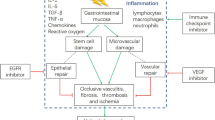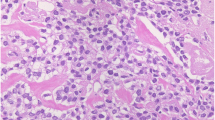Abstract
Enteritis is one of the side effects of radiotherapy to the abdominal cavity. Radiation enteritis involves damage to mucous membranes in the acute phase and to stromal tissues in the late phase. Perforation of the intestine tends to occur in the late phase, and rarely in the acute phase. However, we describe here a case of intestinal perforation occurring in the acute phase after irradiation in a patient who received gefitinib treatment. Gefitinib, one of the epidermal growth factor receptor tyrosine kinase inhibitors (EGFR-TKIs), is widely used to treat non-small cell lung cancer (NSCLC) patients, but is simultaneously known to inhibit wound healing. We suspect that gefitinib may affect regeneration of the small intestinal mucosa injured by irradiation. A 76-year-old woman had NSCLC with metastases to the 5th lumbar, sacral, and right iliac bones. To control the pain from bone metastasis, anterior-posterior opposing portal irradiation (total 35 Gy) was started, and was completed over 22 days. On day 25 after starting radiotherapy, the patient began to take gefitinib. On day 35, she presented with acute peritonitis, and an emergency laparotomy was performed. The terminal ileum was affected by radiation enteritis and there were two pin-hole perforations. In the surgical specimen, no cancerous lesions were detected, and immunohistochemical staining of phosphorylated EGFR (pEGFR) was negative. pEGFR has an important role in mucous membrane repair after irradiation. Intestinal perforation in the acute phase of radiation enteritis may be associated with impaired mucosal repair mechanisms due to the use of an EGFR-TKI such as gefitinib, as evidenced by the absence of pEGFR.




Similar content being viewed by others
References
Kavanagh BD, Pan CC, Dawson LA et al (2010) Radiation dose-volume effects in the stomach and small bowel. Int J Radiat Oncol Biol Phys 76:S101–S107
Yamashita H, Nakagawa K, Tago M et al (2006) Small bowel perforation without tumor recurrence after radiotherapy for cervical carcinoma: report of seven cases. J Obstet Gynaecol Res 32:235–242
Mitsudomi T, Kosaka T, Yatabe Y (2006) Biological and clinical implications of EGFR mutations in lung cancer. Int J Clin Oncol 11:190–198
Yin J, Xu K, Zhang J et al (2007) Wound-induced ATP release and growth receptor activation in epithelial cells. J Cell Sci 120:815–825
Block ER, Klarlund JK (2008) Wounding sheets of epithelial cells activates the epidermal growth factor receptor through distinct short- and long-range mechanisms. Mol Biol Cell 7:4909–4917
Jones MK, Tomikawa M, Mohajer B et al (1999) Gastrointestinal mucosal regeneration: role of growth factors. Front Biosci 4:303–309
Kitagawa K, Hamada Y, Kato Y et al (2004) Epidermal growth factor and interleukin-1β synergistically stimulate the production of nitric oxide in rat intestinal epithelial cells. Am J Physiol Gastrointest Liver Physiol 287:1188–1193
Myhre GM, Toruner M, Abraham S et al (2004) Metalloprotease disintegrin-mediated ectodomain shedding of EGFR ligands promotes intestinal epithelial restitution. Am J Physiol Gastrointest Liver Physiol 287:1213–1219
Nakagawa K, Tamura T, Negoro S et al (2003) Phase I pharmacokinetic trial of the selective oral epidermal growth factor receptor tyrosine kinase inhibitor gefitinib (‘Iressa’, ZD1839) in Japanese patients with solid malignant tumors. Ann Oncol 14:922–930
Zhuang HQ, Sun J, Yuan ZY et al (2009) Radiosensitizing effects of gefitinib at administration times in vitro. Cancer Sci 100:1520–1525
Taira N, Doihara H, Oota T et al (2006) Gefitinib, an epidermal growth factor receptor blockade agent, shows additional or synergistic effects on the radiosensitivity of esophageal cancer cells in vitro. Acta Med Okayama 60:25–34
Gow CH, Chien CR, Chang YL et al (2008) Radiotherapy in lung adenocarcinoma with brain metastasis: effects of activating epidermal growth factor mutations on clinical response. Clin Cancer Res 14:162–168
Conflict of interest
Takayuki Muraoka and the other co-authors have no conflict of interest.
Author information
Authors and Affiliations
Corresponding author
About this article
Cite this article
Muraoka, T., Tsukuda, K., Toyooka, S. et al. Ileal perforation induced by acute radiation injury under gefitinib treatment. Int J Clin Oncol 16, 774–777 (2011). https://doi.org/10.1007/s10147-011-0249-8
Received:
Accepted:
Published:
Issue Date:
DOI: https://doi.org/10.1007/s10147-011-0249-8




